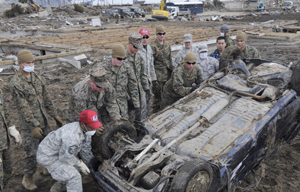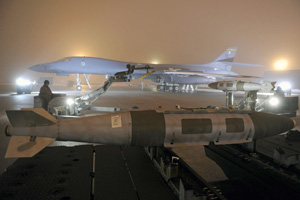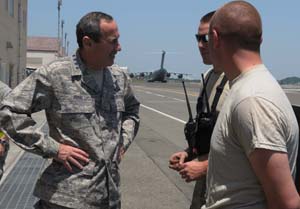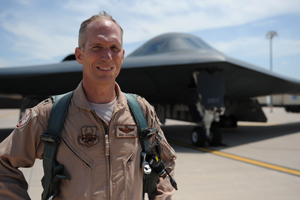The talk around the nation’s capital may be fixated on looming budget cuts and drawing down military forces in Southwest Asia, but top Air Force leaders did their best to remind the attendees at the Air Force Association’s Air & Space Conference that USAF plays a critical and wide-ranging role in both Iraq and Afghanistan. These wars are not over, officials cautioned Sept. 19-21 during the conference in National Harbor, Md.
Furthermore, as recent events have demonstrated, the wars in the US Central Command region are only part of what USAF is called on to do. Pop-up contingencies ranging from disaster relief to air strikes against Muammar Qaddafi’s military forces in Libya have forced operators and leaders to rearrange, improvise, and adapt a force already strained by combat.
Gen. Gilmary Michael Hostage III, Air Combat Command’s new boss, summarized the state of USAF’s careful operational balancing act, by saying he has gone from being a “consumer” of assets (as US Air Forces Central boss) to figuring out how to make sure ACC provides the combatant commanders what they need.
 |
A composite photo depicts the round-the-clock operations at Bagram Airfield, Afghanistan. (Photo composite by Maj. Travis Winslow) |
From August 2009 to August 2011, Hostage oversaw a dramatic shift of forces in the CENTCOM zone. They transitioned from leading combat operations in Operation Iraqi Freedom to support operations in New Dawn; surged forces into Afghanistan; and now will transition combat forces out of Iraq by year’s end. “All I had to do was pick up the phone and call” ACC’s Gen. William M. Fraser III, Hostage said of his time in Southwest Asia. “Now I’ve got the other end of the line, and I have to figure out how to actually make that happen. So I get payback now for two years of pretty much anything I needed, to go to the hard part of figuring out how to produce that.”
Leaders said both air combat and mobility forces face a version of the same daunting challenge: meeting steady state war-footing requirements, while maintaining enough readiness across the Total Force to respond at a moment’s notice to contingency operations around the globe. The past year has shown the need for the Air Force to be ready for these contingencies, even in a time of budget austerity and force realignment.
Air forces over Afghanistan operate at a remarkable tempo today, several leaders noted. Gen. Raymond E. Johns Jr., head of Air Mobility Command, said airdrop operations surged to unprecedented levels as troops steadily ramped up operations in Afghanistan. In 2005, he noted, AMC airlifters dropped two million pounds of cargo across US Central Command. In 2011, AMC is on track to airdrop more than 90 million pounds of fuel, ammunition, water, and other supplies—an average of 6,000 bundles a month.
The ability to lift supplies to just about anywhere in the landlocked country has made the difference in a host of scenarios. Johns told of an air mobility liaison officer who worked a direct airdrop—practically on top of an isolated forward base manned by Romanian soldiers who had only 72 hours of fuel and essential supplies remaining. Nineteen bundles were dropped on top of the base, using low velocity parachutes, because the regular drop zone was inaccessible. “It’s not something we plan every day, … but they were able to do that,” Johns said of the airmen involved in the operation.
Pulling Strings
In Afghanistan today, Air Force Special Operations Command airmen occupy some of the most stressed career fields in the entire force, said AFSOC’s Lt. Gen. Eric E. Fiel. Some air commandos, including many combat controllers and pararescuemen, have deployed to Southwest Asia as many as 20 times. Even with the drawdown looming on the horizon, Fiel said he doesn’t anticipate the pace of operations for his airmen to change much.
“We know we are going to be [in Afghanistan] a long time,” Fiel said, and the repeated tours are adding up. “We have some pretty courageous folks, and they all want to keep going back, but each time they come back, you see just a little piece of them still left over there. There is a lot of pressure on them and an enormous amount of pressure on their families as they continue doing this, but they are great Americans.” To best support special operations forces, Fiel said, he wants to protect, from any budgetary cutbacks coming down, components of certain missions, such as specialized SOF air mobility, precision strike capabilities (e.g., AFSOC’s AC-130 gunships), and special tactics officers. “They are all heavily deployed assets,” Fiel noted. “Getting good guys to target and getting them into the battle is a priority.” This is also one of the reasons AFSOC will start forward deploying some of its CV-22 Ospreys to RAF Mildenhall, England, in Fiscal 2012, he said, and forward deployed assets will become more important as the number of forces in Afghanistan begins to taper off.
“Without having that capability forward, it would really hamper those things that we can do,” Fiel noted.
 |
Airmen and other service members prepare to lift an overturned car in Noda Mura, Japan. Just days before operations began in Libya, a 9.0 earthquake hit Japan, followed by a devastating tsunami. (USAF photo by SrA. Joe McFadden) |
With so much combat power projected toward Afghanistan operations, USAF has had to pull strings in various ways to meet requirements for other contingencies—and no period better illustrated this point quite like “March Madness”—the term US Transportation Command’s Gen. Duncan J. McNabb used to describe the various contingencies that occurred simultaneously this past March. A Presidential trip to South America was already on the books, McNabb said, when a magnitude 9.0 earthquake and subsequent tsunami devastated Japan on March 11.
Just over a week later, Operation Odyssey Dawn—the initial coalition air strikes in support of United Nations Resolution 1973, designed to protect Libyan civilians from Qaddafi’s military—kicked off, necessitating another surge of air mobility assets for operations in North Africa, Europe, and the Middle East. “March was the first time … that every combatant commander had a priority one mission,” he said.
A key element to achieving success in the Libya operation was the quick volunteer mobilization of Air National Guard and Air Force Reserve assets—particularly the air refueling bridge for combat aircraft from multiple countries. Johns noted when the call came for infusion of KC-135s and KC-10s to support Libyan operations, he turned for help to an Air Guardsman with extensive aerial refueling experience: the Pennsylvania ANG’s Brig. Gen. Roy E. Uptegraff III, who commands the 171st Air Refueling Wing. Air Guard tankers returning from Presidential support were turned around in Puerto Rico and sent to Moron AB, Spain, where the 313th Air Expeditionary Wing was taking shape. Active duty airmen were called at bases such as McConnell AFB, Kan., told to pack their bags, and were in the air mere hours later.
“We had a very small planning time frame,” said Lt. Gen. Charles E. Stenner Jr., head of the Air Force Reserve, about the Libya mobilization. “Within 36 hours there were people from 50 different locations and tankers from 50 different locations that descended on Moron, and operated 12 hours later and were putting gas into jets.” The mobilization, all done in the reserve components on a volunteer basis, was critical to the operation. “You can’t do that in any other service. That’s a strength, that’s what we have to leverage: … three components, seamless unity. Train to the same standards, able to respond and react to whatever our nation calls upon us to do,” Stenner said.
“None of these folks who were going out had any idea of how long they would be there,” AMC’s Johns said of the early stages of Odyssey Dawn, noting that Uptegraff returned home after 91 days deployed. “All I heard is, ‘We have a mission.’ “
The mission itself was dynamic, and from a command and control perspective, ensuring the right aircraft got matched with the right air refueling equipment was a great deal of work, Uptegraff said during a panel discussion. “Target sets changed, and there was a lot of movement up there,” he said. Countries were sending assets from across Europe, and not all had a great deal of training with Air Force refueling aircraft. A variety of receivers, probe and drogue and multipoint refueling systems, equipped allied aircraft. “We did have some confusion up there, just because of the configuration of the aircraft,” Uptegraff said. Crews spooled up quickly to operate on different kinds of systems, he noted, and tanker crews continued flying NATO support missions, even after the initial phase of strikes.
Days before Libya kicked off, on the other side of the world, the earthquake struck off the coast of Japan—creating a force so powerful it knocked the Earth slightly off its axis, recalled Lt. Gen. Burton M. Field, commander of 5th Air Force and US Forces Japan. The quake caused Japan’s land mass to sink about a meter into the ocean.
 |
Airmen ready a B-1 on March 27 for an Operation Odyssey Dawn mission. In the foreground, a 2,000-pound JDAM awaits loading. (USAF photo by SSgt. Marc I. Lane) |
The Busiest Day Ever
Soon afterward, a tsunami devastated several hundred miles of coastline and damaged a nuclear reactor in Fukushima prefecture. Unlike victims in Third World countries, the Japanese were able to handle most of the response and led rescue and recovery efforts across the board, but the US military played a significant supporting role, Field said.
Initially, Field led the US response before command and control passed to a US Pacific Command Joint Task Force. “Over the next several weeks, we worked through some humanitarian assistance, disaster relief, [and] consequence management with the interesting nuclear problem, the likes of which we hadn’t really seen for over 20 years,” Field said.
US military forces, along with their Japanese counterparts, tried to measure the amount of danger in the radiological environment around the Fukushima Daiichi nuclear plant, a monumental undertaking, Field recalled. While some of that expertise was resident in Japan, USAF and the other services rapidly pushed into the Pacific, teams such as the Air Force Radiation Assessment Team (AFRAT) from Wright-Patterson AFB, Ohio. “We were able to get all of that capability pushed forward into Japan,” Field said, “and try to figure out a way to assess risk … and make grounded decisions on how we were going to deploy the force.”
The AFRAT airmen went to US bases, the embassy, and other areas housing US citizens and measured the air, soil, and water to characterize the state of the environment.
When it became clear radiation would be a serious concern, at least temporarily, a voluntary departure of DOD civilians and dependents launched—a movement of some 20,000 people in less than a week. Pacific Air Forces took the lead and coordinated the effort with TRANSCOM, which tapped its commercial air partners to help evacuate the citizens.
 |
Gen. Raymond Johns, AMC commander, speaks with airmen at Yokota AB, Japan. The sudden missions to Libya and Japan in March called for a mobility effort unprecedented in the modern Air Force. (USAF photo by A1C Sean Martin) |
“Spring break is an amazing time to ask for commercial lift,” McNabb quipped about the effort—which started as Libya preparations began as well. By the Monday following the earthquake, the first commercial aircraft were taking off from Japan with evacuees, McNabb said. “These airplanes aren’t sitting around, … but when we called, they basically figured out other ways to take care of those customers, paying customers,” he said.
“AMC had its busiest day ever doing Japan and Libya in the same day,” said Gen. Gary L. North, PACAF commander. “It was a phenomenal effort.” What was anticipated to be tens of thousands of evacuees wound up being about 7,800 family members, many routed through Travis AFB, Calif., on the way home.
Before Libya and Japan operations began, a Presidential visit to South America was supported by AMC. The region is the focus of a wide range of partnership building activities and careful efforts to counter illicit drug trafficking networks, according to Air Force Gen. Douglas M. Fraser, commander of US Southern Command.
Unlike Western European or many Pacific allies, the nations of South and Central America have small militaries and need small amounts of specific capabilities, Fraser said. These include intelligence-surveillance-reconnaissance, light airlift, rotary lift, and light attack. Podded sensors on existing aircraft, or platforms such as the MC-12, could be useful as well, Fraser noted, and some countries own similar but older aircraft facing sustainment and spare parts issues.
 |
All then-Lt. Gen. Gilmary Hostage had to do was pick up the phone when he needed combat power as Air Forces Central commander. As ACC commander, Hostage is now the one meeting those needs. (USAF photo by SrA. Carlin Leslie) |
Fraser said SOUTHCOM’s interagency capacity building efforts are a mission “that stresses us … to think differently.”
Countries in the region are locked in a shifting battle of wits with illicit-drug traffickers, as networks have moved from semisubmersible vessels to ship drugs out of South America along the Pacific Coast into Central America, to fully submersible craft, Fraser said. Some vessels are highly sophisticated, with electric motors for underwater operations. Such craft are difficult to detect and expensive to build, Fraser said, but with a load of cocaine worth an estimated $70 million, illicit-drug traffickers are willing to make the investment—and take their chances.
The operational force is also attempting to normalize and standardize practices in the newest operating domain, the cyber arena. Lt. Gen. Michael J. Basla, vice commander of Air Force Space Command, told attendees that 24th Air Force—USAF’s cyber arm—is working to push out so-called “cyber liaison elements” to combined air and space operations centers around the world. These cells provide reachback to 24th Air Force’s 624th Operations Center at Lackland AFB, Tex., where operators are redefining combat operations in the modern era.
“Cross domain” activities are foundational to how America prosecutes war and military operations, Basla said, from relief operations to combat in Afghanistan. A great deal of discussion in the top leadership of the armed forces is under way on how regional taskings for cyber effects will occur, he noted. Regional commanders want organic capability, but there is limited capacity for these sorts of billets now. “Some cyber forward footprint will be able to happen. … Someone has to understand the [area of responsibility] and the challenges, and that’s hard to do from a rear location,” he added, noting another difficulty is carrying out cyber operations in time-critical taskings when geographically dispersed.
Basla said it is important for the Air Force to focus on cyber and space capabilities because of their relationship to all other operations. “We need to have professionals—to have airmen—have an understanding, a common denominator of these cyber fundamentals,” he said. “In an era of austerity, we cannot afford to develop just a third of our people.”
|
Space Not Immune to the Terrestrial Budget Crunch The United States must maintain at least a minimum level of space capability if it wants to remain a global power, Gen. William L. Shelton, Air Force Space Command commander, warned attendees at AFA’s Air & Space Conference at National Harbor, Md. “Times are tough,” said Shelton during his Sept. 20 address, acknowledging the budgetary decisions looming for the US military. However, he said, “I believe that there is a limit to how far we can and should cut.” For example, “we can’t stop doing GPS,” stated Shelton, adding that the Global Positioning System truly is a critical national—and not just a military—asset. Similarly, space-based missile warning, space situational awareness, and the nuclear warning missions are indispensable, he said. Twenty percent of Air Force modernization dollars go to space systems, so service officials are “increasingly exploring creative ways” at the macro level to drive costs down, said Erin C. Conaton, undersecretary of the Air Force, Sept. 20. Conaton helped conceive the service’s Evolutionary Acquisition for Space Efficiency, or EASE, proposal that lays out initiatives such as block buys of satellites and stablizing research and development investment. Thus far, Congress has embraced some, but not all, of this proposal. The Air Force also seeks block buys of launch vehicles and wants to attract new entrants into the launch vehicle sector in order to operate more affordably and efficiently. Shelton said AFSPC has done and will continue to do its part to shave costs and operate more efficiently. He cited AFSPC’s restructure of the Joint Space Operations Center Mission System—designed to provide unprecedented levels of command and control for the space situational awareness mission—that saved “lots of money” and was fielded on an accelerated schedule. The budget crunch could mean USAF may have to jettison some nice-to-have niche capabilities, such as the X-37B reusable spaceplane, said Shelton. They are “very flexible” and “wonderful” platforms for inserting experimental payloads into space and later returning the payloads to Earth, he said. But “as you rack and stack all of the priorities that we’ve got, it remains to be seen how these . . . will stack up,” he said. At least partly with cost reduction in mind, Air Force space officials already are rethinking the makeup of USAF’s future on-orbit capability. Lt. Gen. Ellen M. Pawlikowski, commander of the Space and Missile Systems Center at Los Angeles AFB, Calif., said tomorrow’s constellations will probably rely less on sophisticated military-specific satellites and more on some level of simplified military spacecraft coupled with supplemental on-orbit capability like payloads hosted on commercial satellites. “I like to think of it as a change in the composition of what the architecture looks like as opposed to a complete change of the architecture,” she said Sept. 19. “What I think we will be able to do is potentially simplify those [military-specific] satellites so that we will reduce the cost of the backbone.” For example, Pawlikowski said, instead of building solely a large constellation of Advanced Extremely High Frequency satellites for protected military communications, the nation also could invest in “a tactical advanced EHF” system, thus reducing the number of sophisticated AEHF spacecraft needed. Already the Air Force has established an office to oversee its hosted payload activities, noted Pawlikowski. On Sept. 21, the last day of the conference, the service’s first hosted sensor, the Commercially Hosted Infrared Payload reached orbit. CHIRP is the first-ever wide-field-of-view IR sensor to reach space, and it was boosted by Arianespace from a spaceport in Kourou, French Guiana. SMC has also shifted its focus from developing new satellites to producing them efficiently and filling out planned constellations of new capability, said Pawlikowski. Along those lines, the center has modified its approach to incorporating new technology into satellites, she said. Officials now look at what technology is mature and then decide if it makes sense to incorporate it into a satellite design. That’s different from committing up front to inserting new technology in a given satellite in a series, which is a riskier endeavor, she said. —Michael C. Sirak |